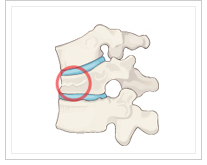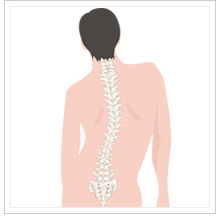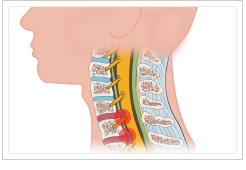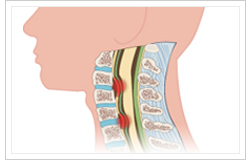


A lumbar disc refers to a condition in which discs are dislocated from the original locations and press on the nerves that pass through the spinal canal, resulting in their failure to perform their original functions to absorb shocks, like a cushion, between the vertebrae and thus cause pain in the back. The main causes of the condition are degenerative changes of the spine and injuries from activities, but the condition can easily occur in regular people without any specific causes. The preventive treatment for the condition includes mental and physical stability therapy, physical therapy and exercise therapy, while the surgical treatment includes Microscopic Lumbar Discectomy (MLD) and Percutaneous Endoscopic Lumbar Discectomy(PELD). Nanoori Hospital performs the surgery based on an accurate diagnosis by medical teams with much experience of this condition. The period of hospitalization is about three to five days, although the period can vary according to different surgeries. In some cases, patients may need to wear a lumbar pad for a period of time.

Spinal stenosis refers to a condition in which the spinal canal becomes narrow and presses on nerves that pass through the canal. The narrowed spinal canal causes inflammation and stenosis. The disease normally occurs in people who are over 50 years old simply as a result of the aging process. As people get older, the joints and ligaments become bigger, and spines grow and press on the spinal canal. The most common symptoms of this disease include a bent back, difficulty walking for a long time, and severe pain in the legs and back. The symptoms can improve by conservative treatment and physical therapy (neural therapy and percutaneous epidural neuroplasty), and it is necessary for patients who have a problem with mobility.


Spinal compression fractures often occur in the backbone and waist as the shape of the spine is deformed, like a flattened bone. The condition can easily occur when a person is hit by a heavy falling object, falls heavily to the ground, or slips and falls heavily on the hip, shocking the back. The main causes of this condition are osteoporosis and aging bones. It occurs in elderly people in their 60s and 70s. To treat the condition, a therapy to relieve pain and physical therapy are needed. In cases where spinal shock, waist-down paralysis and the injury of nerve roots are expected, surgery is required.


Scoliosis refers to a condition in which a person's spine is excessively curved from side to side. The symptoms of scoliosis are that the height of both shoulders and pelvis are different, and the body is inclined to one side because of the deformation of the spine, resulting in an "S" stature. The condition normally develops in teenagers. While 70% of patients with the condition have no specific causes, others have the condition because of bad posture and/or genetic causes. The treatment can be done by strengthening the muscles of the front, back and side of the spine according to the severity of the crooked shape of the spine, or by wearing a spine corrector. It is possible to treat a patient with a more severe condition with surgery to adjust the angle of the spine. If the condition is left untreated for an extended period time, it can lead to the injury of internal organs, so careful treatment is required.

Osteoporosis refers to a condition in which fractures can easily occur because the bones become weak as the density of the bones is reduced, resulting in inferior bone quality. The disease is accompanied by various symptoms, including pain in the fractured region. The main causes of the condition include low bone density due to genetic factors, premature ovarian failure, smoking and drinking. Osteoporosis is diagnosed by a bone density examination. If there is a possibility that a patient has spinal stenosis, the patient needs to consult with a physician specializing in the disease, and take medication, as well as adjusting and improving their lifestyle and remove dangerous factors which may result in fractures. Nanoori Hospital performs the state-of-the-art operation called balloon kypoplasyto to inject medical cement into the weakened spine to support the spine.

It is common that there are many difficulties in treating patients with spine diseases because it is hard to find the clear cause for their condition through examinations. Medical teams having much experience with spine diseases at Nanoori Hospital provide a consultation to patients with back pain resulting from undetermined causes or non-specific symptoms. The medical team uses cutting-edge examination equipment to ensure the best results are achieved. Nanoori Hospital proposes appropriate treatment to each patient by accurately examining the condition and symptoms of the patient.





A herniated cervical disc refers to a condition in which a disc is protruding from the cervical vertebrae (neck bones), or where bones grow in an abnormal manner so that they press on the spinal nerves that pass through the neck and cause pain. The main causes of this disease include degenerative changes, the reduction of water within discs, mild injuries resulting from activities due to the reduction of resilience of the body, and bad posture. If you feel pain in the arms, there is a chance that you have a cervical disc problem. The condition can be treated by a medication therapy and physical therapy in the early stages. The method of the surgical treatment is as follows: first, to incise the front side of the neck, remove the herniated discs and agglutinate the bones; second, to insert artificial discs; lastly, to implement percutaneous endoscopic lumbar discectomy, which removes only the herniated nucleus pulposus.


Ossification of the posterior longitudinal ligament refers to a condition in which the posterior longitudinal ligament hardens because the ligament in the rear of the neck fails to perform its role in maintaining the neck bones in the correct location. The disease frequently occurs in Asian people, including Koreans, Japanese, Chinese and Mongolians, and the cause of the condition seems to be related to genetic and racial factors. It is reported that the ossification of the posterior longitudinal ligament is related to injuries, diabetes, immune diseases, and diffuse osteoporosis. In the past, the disease was treated only by conservative treatment that relieved the pain temporarily with medication, because it was hard to cure the condition. Nowadays, Nanoori Hospital is adopting and implementing various new treatment methods for this disease.
















































